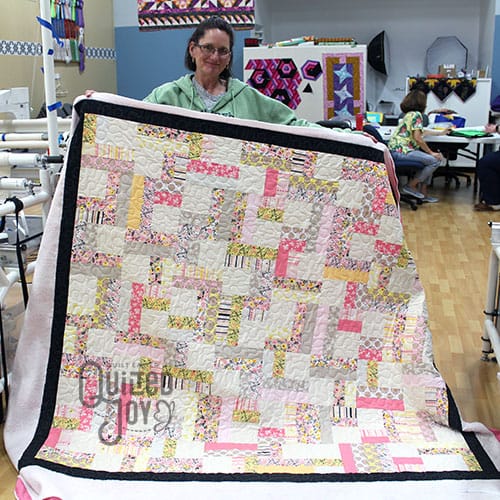

You fill out the form on my website giving as much info as you’d like about your quilt. Here’s what happens if you decide to work with me. You're just stabilizing it with thread to resist warping or stretching or unraveling. Stay stitching means you sew a straight seam all the way around the perimeter–say ⅛" in from the edge–with nothing else layered to it. Sometimes a stay stitching around the perimeter is needed. If you have seams that are starting to come out along the sides or bias edges around the perimeter (prone to stretching), stay stitch around the quilt.If the quilt is square, maybe it doesn't matter at all which direction the quilt goes, but sometimes the quilting design is directional and then it might make a difference to identify the top if you have a preference. they put a safety pin in the center of the top side if there's any confusion. There is a secret signal I learned early on from customers more seasoned than myself. If you have a specific direction that either the top or backing needs to be, make sure you let your quilter know. Give clear direction with your directional fabric.This reduces bulk and looks smoother than pressing to the side. When you piece your backing together, horizontal seams across the backing are preferable but vertical seams will work, too. I even encourage my customers to buy a wide backing online and have it shipped to me, just to avoid extra shipping.

Lots of fabric manufacturers produce 108" wide backs that are suitable for most quilt tops. Do you HATE to piece your backing? I kind of do.

Your backing should be at least 68" x 68" = four extra inches on the top, right side, bottom and left side. Say you have a quilt that measures 60" x 60". I need at least 4" extra on every side of the top for it to be loaded properly. Different quilters have different frames and loading systems and therefore different requirements. The backing NEEDS to be bigger than the top.In order to like it again, you need to send it to someone else for that sweet quilting magic so when you get it back, it's a wonderful reunion! Have you ever been, like, DONE with a quilt? Emotionally speaking? If you get to that point, it might be a good time to call in a longarmer. I have customers that find it physically challenging to baste a quilt and manipulate the quilt sandwich and would simply rather not. Size. I have some customers who actually like to quilt and are good at it, but maybe the bed sized quilt is too big to be an enjoyable endeavor.A blunt way of saying it: They're afraid they'll ruin it. They spend a lot of time and money sewing the quilt top and they know their vision for the finished quilt exceeds what they might be capable of. Many of my customers are not confident in their own quilting skills. If you don’t enjoy the process, why force yourself to do it? If you just want to piece your tops and move on, hiring a longarm quilter is a time-effective way to finish what you start instead of having tops pile up unused. There are different reasons for hiring a longarm quilter.


 0 kommentar(er)
0 kommentar(er)
